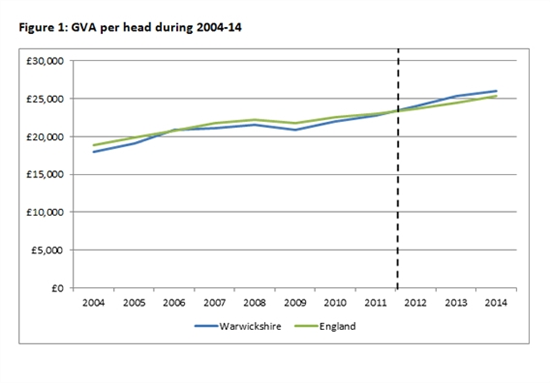Warwickshire Outlook
The latest GVA (Gross Value Added) data released by ONS shows a consistent increase in Warwickshire’s GVA per capita, surpassing the national average. As this is a measure of economic wellbeing, this suggests that residents in Warwickshire remain more prosperous than the average resident in England.

Source: ONS; Mid-population estimates
The county has seen a fast rate of recovery since the 2008 recession, allowing Warwickshire to overtake the national average from 2011 until present. In 2014, £26,003 was produced per head in Warwickshire, compared to £25,367 nationally.
Warwickshire is one of just three areas in the Midlands that have a GVA per head figure above the national average (the other two being Nottingham and Solihull). However, England’s recent growth of 4% doubled Warwickshire’s growth (2%) during 2013-14; implying that there has been a temporary slowdown in total output produced in the economy.
In terms of output by sector, Warwickshire has continued to grow a thriving industrial base. The Distribution, Transport, Accommodation and Food industries achieved the highest combined growth of 10%, with Agriculture, Forestry and Fishing” (6%) and Manufacturing (4%) following close behind. This differs to England’s growth in its service industries; reflecting the importance of priority sectors such as Transport & Logistics and Advanced Manufacturing Engineering to Warwickshire’s economy in terms of jobs and investment.
Concerns over global economic growth in 2016
As is the way at the beginning of a new year, there are plenty of plenty of people offering forecasts for what might happen to the economy over the next 12 months. While all attempts to predict the future are inherently risky, there does seem to be a fairly consistent view that it will be a difficult year for the global economy.
George Osborne has warned of a “cocktail of threats” to the UK, including weakening share and commodity prices, continued slowing and uncertainty in the key BRIC economies of Brazil, Russia and China; and increased global-political tensions all creating headwinds to our economy.
The International Monetary Fund has predicted that economic growth in 2016 will be “disappointing and uneven” and they have downgraded their forecasts for both the near and medium term. The World Bank has said that the global economy could be hit by a “perfect storm” in 2016 as it warns of a simultaneous slow-down within the world’s biggest emerging market, significantly reducing demand for goods and services.
Finally, George Soros (the much-revered billionaire stock-market speculator) has claimed that the world risks a return to the turmoil of the 2008 economic crisis, largely due to structural difficulties in the Chinese economy and associated flows of global capital into that market.
The uncertainty facing the global economy is clearly affecting exports from UK companies. Official figures show that factory output reduced significantly in the latter half of 2015, and according to the British Chambers of Commerce (who collate data from economic surveys by local chambers of commerce), export sales by manufacturing companies fell to below their pre-recession levels and future orders were down. This means that UK growth continues to be led by the service sector, and our trade deficit (the difference between imports and exports) remains worryingly high. If the forecasts for global growth in 2016 come true, this position is unlikely to change much.
UK record car sales fuel JLR success
New car sales reached an all-time high in Britain in 2015 as improving consumer confidence, wage growth and low-interest finance deals from manufacturers boosted the market. A total of 2.63m new cars hit the UK’s roads an increase of 6.3% on 2014 and above the previous record of 2.58m, set in 2003.
The head of the Society of Motor Manufacturers and Traders (SMMT), which provided the figures, said the British market had a remarkable period of growth. New car sales in December were also a record, rising by 8.4% year-on-year to 180,077 vehicles. It is only the fourth time UK car sales have surpassed 2.5m in a calendar year.
Last year also saw record figures for Britain’s biggest carmaker, Jaguar Land Rover, which achieved record UK sales of more than 100,000.
JLR said sales in the country rose 22% to 100,787, making the UK the biggest market for the luxury carmaker. The company reported strong sales of the Jaguar XE and XF as well as the Range Rover Sport and Range Rover Evoque.
* The Warwickshire Outlook has been contributed to by Warwickshire County Council economist Natalie Henderson, a profile of whom can be read here.